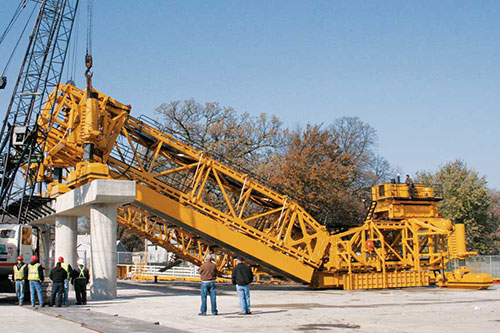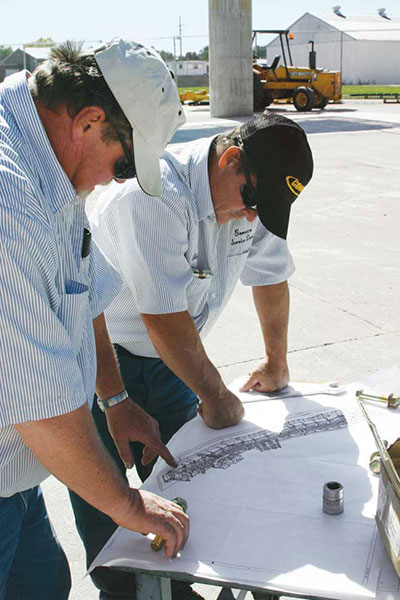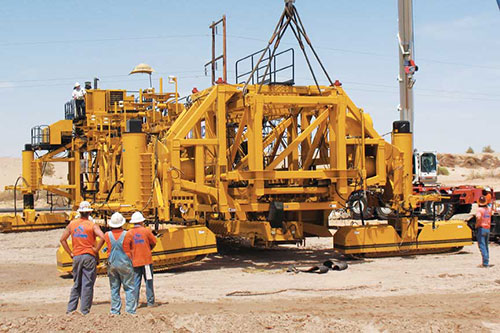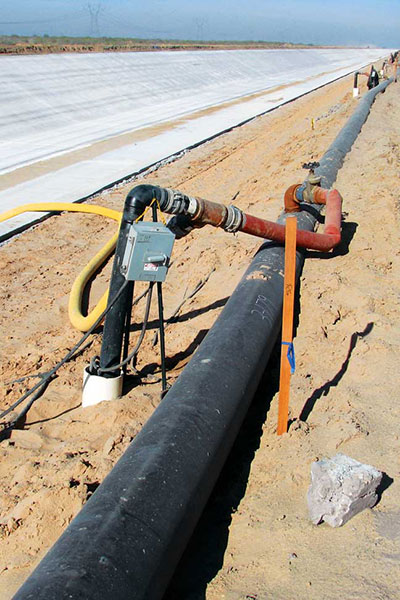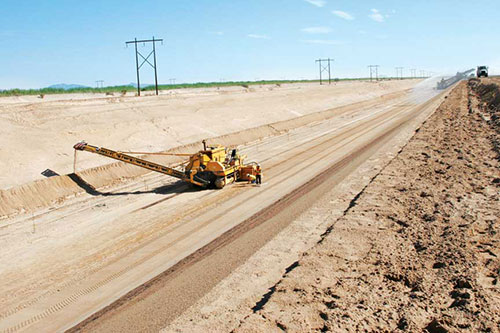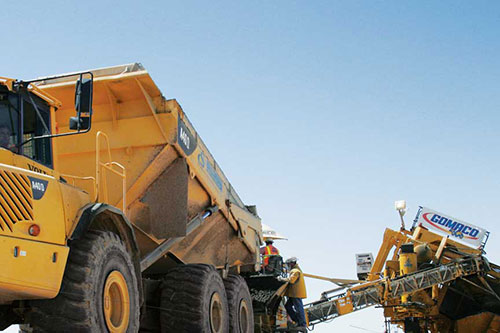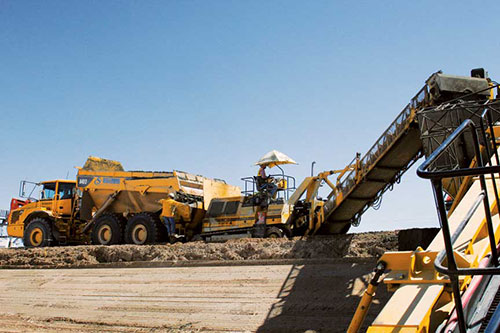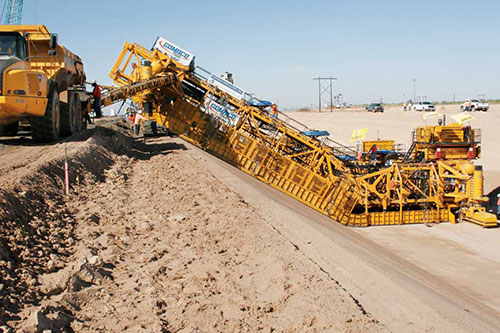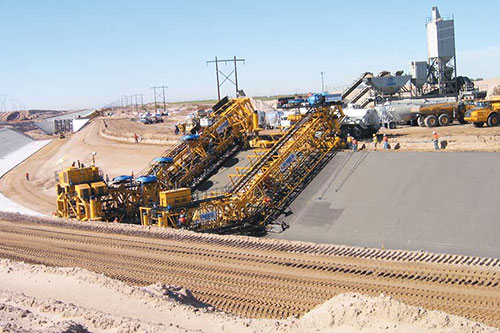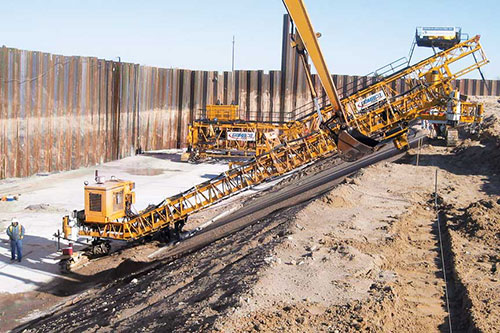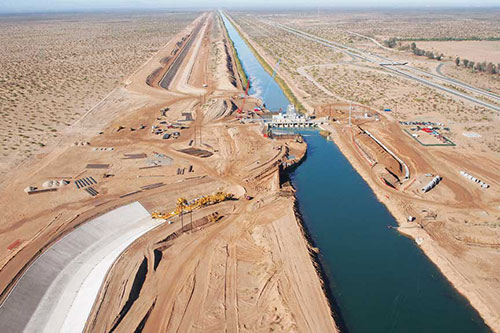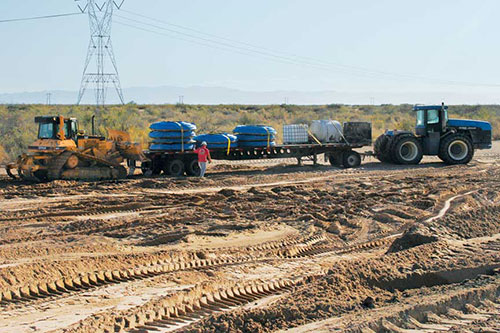GOMACO World Index --- GOMACO World 36.2 - July 2008
Page 4
GOMACO’s testing pier in Ida Grove simulates the slope of the canal and allowed engineers to test the different operations of the canal equipment and its many specially-designed features.
Testing the Equipment at Home –
The final phase of the equipment’s design and manufacturing was full machine assembly. GOMACO constructed a new canal assembly and testing site at their company headquarters in Ida Grove, Iowa, USA. The site includes a concrete pier that is 16 feet (4.9 m) tall, 60 feet (18.3 m) long, and 72 inches (1829 mm) wide. It can accommodate almost any size canal paver, as the All-American Canal equipment has proven.
Each piece of the equipment was fully assembled and then placed on the pier so engineers could test its various features and performance capabilities. Ric Moser, a GOMACO service representative, was assigned to the canal equipment from the very beginning of the project. He was involved in the design process, assembly and later followed the equipment to the project site.
“It was very important and helpful for us to pre-assemble the equipment here on the pier and work it through several tests,” Moser said. “These were custom built machines and this allowed us to make sure we had all of the angles correct, get it up on its own load and under its own weight to see how the frame was going to behave.”
The canal equipment was later disassembled and shipped. Twenty truckloads were needed to transport all of the canal paving equipment to California.
Assembly in the Desert –
It was a monumental task coordinating the assembly of not only the GOMACO equipment at the project site, but other extremely large pieces of equipment, as well. GOMACO’s 20 truckloads of equipment was just part of the deliveries going into the desert.
“Logistically, it was significantly complex in that there was quite a lot of big equipment that had to be moved to site,” Jim Coffman explained. “For example, our 275 ton Kobelco crane that we used to assemble and position the paving equipment was 13 truck loads, itself. The canal trimmer was another 10 loads. It wasn’t insurmountable, but there were a lot of loads of equipment to get there and put together. It took us two and one-half months to put all the equipment together initially.”
Assembly on the GOMACO equipment began in July 2007. Moser was on hand for final assembly and to help coordinate the GOMACO team and Coffman Specialties’ crew.
“Assembly in the desert clicked along because we spent so much time at the canal testing site in Ida Grove assembling these machines and testing all of their functions,” Homan said. “Ric was involved in all that, and then he took his expertise out there on final assembly and everything went together really well.”
“Everything was preassembled on-site in the flat configuration,” Moser added. “Coffmans provided plenty of help, all the necessary tools and equipment, lifting devices both large and small, and the assembly went together pretty good. Everybody pulled together as we accomplished the final assembly.”
The Test Pours –
With final assembly completed, the equipment in the canal and set to the proper slope, it was time for a series of test pours in early October 2007. The new machines would have concrete run through them for the first time. All of the new technology on the machines, from the water stop inserter mechanisms to the paddle concrete distribution system, was about to be tested in the California desert.
“I have to admit, I was a little nervous before that first test pour,” Homan said. “We weren’t dealing with just one new thing, everything was new. It wasn’t just one machine, it was three machines. It was a little nerve wracking and kind of like having a child all over again. There were just so many things that had to happen to keep that paving train moving down the line.”
One of the main concerns of the test pour was getting the proper slope angle set on both the paver and the water stop machine. They had to be able to match the grade the trimmer was preparing. The water stop machine also had to match the paver for the proper insertion of the water stop material. Keep in mind, also, that these machines were paving almost 72 feet (21.9 m) wide at a 1.75:1 slope on the initial test pour and for the first section of canal.
“Going into the paving portion of the canal, I was concerned about a few things,” Coffman said. “I knew it would be challenging to get concrete delivery to the paver and then distribute that concrete onto the slope. The insertion of the water stops, the four longitudinally and the one transverse, was also a very large concern.
“We decided to have three test pours so we could really learn what we were doing so when we started paving, we were ready to go. It gave us a chance to emulate the actual work that we were going to be accomplishing.”
During the first test pour, approximately 150 feet (45.7 m) of concrete was poured. More importantly, crucial information was learned about the paving process, what things worked successfully and what things would need to be tweaked for the next test pour.
“We had a few starts and stops that first day, literal starts and stops due to delivery, and getting concrete from the plant to the machine,” Moser said. “We had a few first day problems, but nothing that couldn’t be sorted out. I know my happiest day on the project was when I saw that first bit of concrete come out from behind the paver. I was always confident the paver and the slipform process would work and that first test pour proved it.”
Two more test pours were conducted in October, each one used to continue to refine and tweak the equipment and the canal paving process. Actual paving of the canal began in early November 2007.
Excavating the Canal –
Coffman Specialties’ joint venture partner, Ames Construction, Inc., with corporate headquarters in Burnsville, Minnesota, was responsible for the excavation portion of the new canal. Ames brought in their fleet of rubber-tracked Caterpillar® Challenger tractors with tandem-drag scrapers. All of the canal prism was excavated using GPS technology and GPS controlled equipment. It allowed Ames to leave the newly excavated canal at a certain depth, with approximately eight to 12 inches (203 to 305 mm) left for final trimming.
A mandrel, bucket-wheeled trimmer was used to trim the excess material to the final grade. GOMACO even had a hand in renovating Coffman’s canal trimmer.
“We utilized GOMACO’s past knowledge and current technology to improve and change the drive system on our trimmer,” Coffman said. “We gave it a hydraulic drive system that made it much more maneuverable. With the old system, it would only travel four to six feet (1.2 to 1.8 m) per minute in any one direction whether it was trimming or not. We improved that travel speed to 22 feet (6.7 m) per minute and GOMACO helped us do that.
“Also, we put a GOMACO G21 control system on it to get better control and more up-to-date sensoring abilities in order to be able to trim the final grade more accurately.”
Approximately five million cubic yards (3,822,774 m3) of sandy material was excavated on the Ames/Coffman joint venture portion of the All-American Canal.
Timing the trimming operation to the paving operation was a crucial aspect of the project. Specifications restricted how far ahead of the paving the trimming operation could be.
“The specifications require no more than 6000 feet (1829 m) ahead with the trimmer,” Kevin Coffman explained. “With the desert and the maintenance on the slope, we always have to properly gauge that so we’re as effective as possible. If there’s a storm coming in with extreme winds, we have to pull the trimmer back in and get the paver right on its tail. Then, vice versa, when we get good weather we try to run that trimmer out as far as possible and let the paver get a good run at it.”
Dewatering the Canal –
Another significant portion of the joint-venture’s project is dewatering the canal. Seepage from the old, unlined canal wants to leak into the newly created canal. Project specifications require the water table must be kept 24 inches (610 mm) below the paving invert at the time the pavement was to be slipformed.
Wells were placed every 100 feet (30.5 m) on centers along the length of the canal. Each well pumps 600 gallons (2271 l) per minute in order to keep the water table below the canal prism. The dewatering of the canal process has to continue until paving is complete and water from the old canal is diverted into the new concrete lined canal.
The water was also used as part of a sprinkler system. The top trimmed lines of the canal are kept wet with a continuous sprinkler system to keep the wind from eroding the profile and blowing the sandy surface away.
Supplying the Concrete –
Coffman Specialties has a 12 cubic yard (9.2 m3) Erie Strayer central mix plant set up on site mixing all of the concrete for their portion of the canal project. The plant has production capabilities of 300 cubic yards (229 m3) per hour.
The concrete is a conventional mix design with an approximate 60 percent course aggregate and 40 percent fine aggregate make-up with a 3000 psi (25 MPa) strength requirement. Slump averages three inches (76 mm). For Coffman Specialties, the workability of the mix is its most important attribute.
“The important thing was the mix had to have good characteristics of workability,” Jim Coffman said. “Not only for placement, but also for inserting the water stop material and then closing up that void around the water stop as it was inserted. Workability was imperative.”
It was apparent, too, that conventional trucks used to transport concrete on highway projects would not be capable of handling the project’s sandy conditions. It would be very difficult for 10 to 12 cubic yard (7.6 to 9.2 m3) trucks to keep up with the supply demands of the huge paver.
Coffman Specialties used eight Volvo A40D 6x6 articulated haulers to haul the concrete. Each one is capable of traveling over the sandy terrain while hauling a complete load of concrete to the paving site.
Navigating through the desert’s sandy terrain was definitely a challenge, not only for the concrete trucks, but for everyone on the project. Vehicles getting stuck in the loose sand was a common occurrence.
“It was impossible to drive in the sand and I never did learn how to do it without getting stuck,” Moser said. “I’d go in the morning and put my tow strap on the hood of my truck and leave it there all day. I knew I’d need to be pulled out at least once or twice before the day was out.”
Placing the Concrete –
The articulated haulers have a maximum six mile (9.7 km) trip to deliver concrete to the paving site from the batch plant. At the site, they dump their load into the hopper of a GOMACO RTP-500 rubber-tracked placer. The hopper was slightly modified by Coffman’s fabricators and made wider to more easily accommodate the width of the haulers.
“We were able to unload 10 loads per hour if everything was in sync,” Coffman said. “The RTP and the articulated haulers really marry up well together. You’re actually backing in half as many times per hour with these types of trucks.”
The RTP-500 is equipped with the auto-index feature to help make things easier for the operator. Auto-index uses a sensor mounted to the end of the RTP-500’s placing belt. The sensor touches against the leg of the paver and as the paver moves forward, the RTP moves forward in unison with it. The operator doesn’t have to worry about pulling too far ahead of the paver and dumping concrete onto the ground instead of into the concrete handling system. Or vice versa, not moving ahead enough and having the paver run into the RTP’s belt.
“When the paver presses the sensor, the RTP-500 automatically begins to travel forward proportionally,” Moser said. “If the paver goes slow, the RTP goes slow. It’s as simple as that with auto-index. It frees up the operator so he can focus on steering the RTP, turning the belts on and off, and watching the trucks. A full-time guy on the ground guided the trucks in and out. It all worked good and was very well orchestrated.”
One RTP-500 placed all of the concrete for Coffman Specialties, approximately 95,000 cubic yards (72,633 m3).
Coffman Specialties paved one of the canal’s transition areas while the excavation of the next phase continued ahead of them.
The All-American Canal In GOMACO World Vol. 36, No. 2
Page 1 - Page 2 - Page 3 - Page 4 - Page 5 - Page 6 - Page 7 - Page 8 - Page 9 - Page 10
